BASS PROJECTS
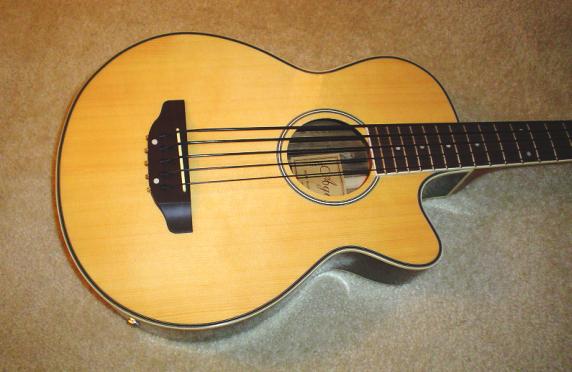
AGILE HEA-30B5 BASS
Well, if I was going to add a different bass to my collection, this one certainly fits the bill.
My first bass was a medium-scale Fender Squire P-Bass, with some pretty serious modifications. My second bass was a long-scale, pieced-together Jazz relic. My third bass was a short-scale Fender Squire Bronco with a guitar pickup. So what was I missing? Well, all of the above are 4-string, electric basses. So I guess I needed a 5-string, acoustic bass. And I got a good one for a great deal.
I saw this 5-string Agile acoustic/electic bass on the Internet (Rondo Music, NJ) for less than $250. It has a spruce top with rosewood for the back and sides, and an Artec piezo pickup/preamp. The stock tuners are just fine and the neck/frets are better than expected. And both the body and neck are fully bound. It looks very cool.
I had to modify it in some way, right? I added the obvious chrome Schaller straplocks and instead of going with the stock acoustic bronze strings, I re-strung it with La Bella black tape-wound strings for more of a fretless sound/feel. And that's it. I did briefly toy with the idea of sanding down the headstock and putting a Martin decal on there, but that's a lot of work.
Let me just say that the low B on a 5-string is intense. And I'm confident that this bass will be used prominently on future recordings, and its acoustic qualities will give me some very unique recording possibilities.
December 2006

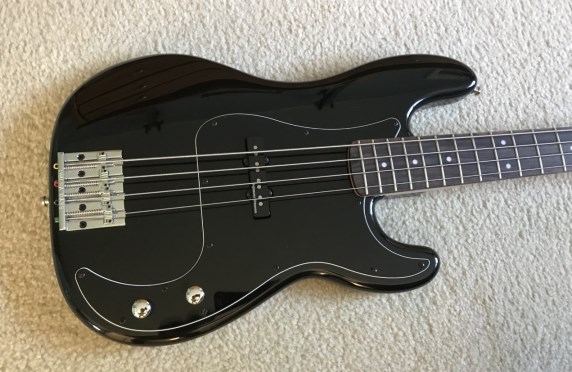
CHARVEL EVH FRANKENSTEIN J BASS
CHARVEL PRECISION JAZZ ONE BASS
Under construction...
Edward Van Halen with a Kramer Duke bass at the New Jersey factory, circa 1982
EVH with a Steinberger bass, circa 1983
EVH with Sammy Hagar and a Kramer Spector bass circa 1987
fan's striped Frankenstein Precision Bass
fan's striped Frankenstein Jazz Bass
Wolfgang Van Halen's Red Frankenstein Bass
VH-signed Blue Frankenstein Bass
alder KnE Frankenstein bass body with Fender Squier roasted maple neck
satin olive green Fender Squier Contemporary Active Jazz Bass HH, with roasted maple neck
painted KnE body with Warman MM4 Alnico V bass humbucker and Hipshot KickAss bridge
dummy Jazz neck pickup and 5-way switch
custom cut pickguard with white "TONE" volume and a mini black tone knob, along with the custom routed Strat jack plate
custom black Charvel EVH Art Series neck plate
-- -- -- -- -- --
Bass #2 story...
my Fender Blackout Stratocaster guitar
body from a Fender Squier Classic Vibe PBass
Squier Classic Vibe PBass body routed for a Jazz pickup
control cavity with inner view of the Strat jack on the back of body
Seymour Duncan Hot Stack Jazz pickup in the custom Warmoth pickguard
chrome Omega "BadAss" bridge and chrome knobs look great on the all black body
custom black Charvel neck plate

CHARVEL -Green Machine- 5 BASS
Under construction...
Squier 5-string Jazz Bass
painted metallic green (like my first bike)
G.M. Ceramic Soap Bar pickup under the pickguard
G.M. Ceramic Blade pickups
Hipshot KickAss 5 bridge
replica Charvel neck plate (Green Machine)
4 knobs (one for each pickup and a master tone) and the custom-routed Strat jack
body back
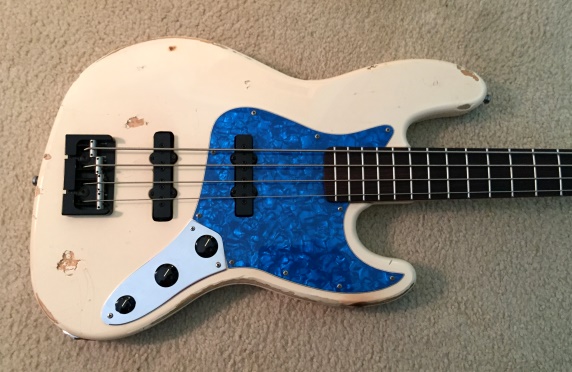
ESP JAZZ BASS
I got the idea to do a Jazz bass from my friend Mike Petersen, who told me back in 1998 that it had a really cool sound. In the fall of 1999, I stumbled upon a 1996 Fender Squier Jazz bass (made in Mexico) at Melodee Music in Sterling. The poplar body had (has) an ivory finish and crappy hardware - I ended up buying it, basically for the body. It took me a while to figure out what I wanted to do with it and to get the parts I needed.
I ordered a custom blue shell pickguard from Chandler and a set of DiMarzio Model J pickups from Musician's Friend. The DiMarzios were a little bigger than the stock Squier pickups, so I had to route out the body and pickguard a little bit so they would fit. I picked up a Carvin/Hipshot bridge and some Carvin knobs and electronics (pots, jack, on/off switch). I routed a hole on the side for a football jack plate, and added an on/off switch to the bass. I also added the standard Schaller straplocks. The stock tuners weren't too bad, but I still wasn't happy with the bass. The neck had to go.
During the summer of 2000, I saw an unfinished maple ESP bass neck (34") with a rosewood fretboard on eBay that intrigued me. It had a Telecaster headstock and the back of the neck had a comfortable V contour; the back of the headstock was partially embossed, ESP, and the butt end was stamped with the ESP logo. Precision Guitar in Phoenix was selling the neck and they let me know that it was originally intended to go on a custom bass for rock bassist Greg Chaisson, formerly of Badlands. This new neck made all the difference, and it plays great! And to top it all off, I had a custom-made ESP neck plate made in blue aluminum - looks really cool and it matches the pickguard.
OK, I have to explain. Even though I bought the body used, it wasn't beat to crap then like it is now. I tried to turn it into a relic. I scratched the heck out of it, beat it with a hammer, burned it, etc. When I installed the new bridge, I made it for a strings-through-body mount, and I wasn't very accurate trying to put the ferrules in, as seen on the back of the body. Oh well - it plays great, and I don't have to worry about dinging it.
February 2002
UPDATE: April 2018
I tracked down a cool ESP Custom Shop waterslide, so I applied that to the headstock, cleaned/oiled the fretboard, and adjusted the action. I have to say, this is such a nice neck - even after 20 years! Also, the controls were getting a little scratchy, so I decided to tear out the Carvin guts (20 years old!) and replace everything with quality parts: 2-500K CTS pots (volumes), a 250K CTS pot (tone), a Switchcraft jack, and an Orange Drop .047 capacitor. I got rid of the on-off switch and thus the need for a 4th hole in the control plate, so I tracked down a 3-hole plate and aged it up. I also replaced the black metal Carvin knobs with the standard Jazz bass knobs, so although it looks pretty much the same, it now has top-of-the-line components under the hood!
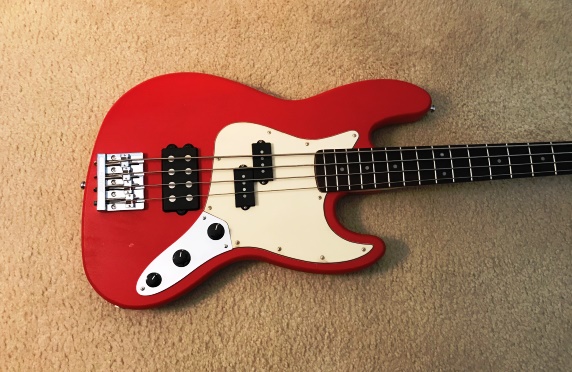
FENDER CUSTOM RED JAZZ BASS
A different take on a Jazz bass.
When I put my Fender PJ Jazz Vintage Bass together in 2016, I thought it was cool to have a Precision pickup (as well as the bridge position Jazz pickup) on a Jazz body. So for this project, I thought I would kinda stick with that theme, and do another Jazz body variation.
I started with an unfinished poplar Rosser body (my third one now, after my Fender Precision Bass -Active Vintage- and Fender Vintage Pine Tele Bass. I had it routed for a PBass middle pickup and a Music Man bridge humbucker. I sprayed it matte red and then this project really started to take shape, especially after I added the Fender High Mass bridge. For the neck, I ordered a solid Mighty Mite PBass (maple/rosewood) and added chrome Squier tuners. I also found a company on eBay that made Jazz Bass pickguards with PBass pickup routing, so I ordered one in cream.
For the pickups, I went with two trusty GFS Pro Series - PBass and MM. I wired it up with XGP 330k pots in the standard vol/vol/tone pattern (with an Orange Drop .047 cap), and had a 7/8" side jack hole drilled for an Electrosocket.
The Fender High Mass bridge has some heft to it - one of the closest you'll get to the old Leo Quan BadAss II bridges, along with the Omega "BadAss" and the Hipshot KickAss. To allow it to be a Fender tribute, I added a chrome Fender neck plate. This Jazz bass body looks unique with the PBass route in a Jazz pickguard and in general with the red/cream color scheme. A great-playing bass!
September 2020
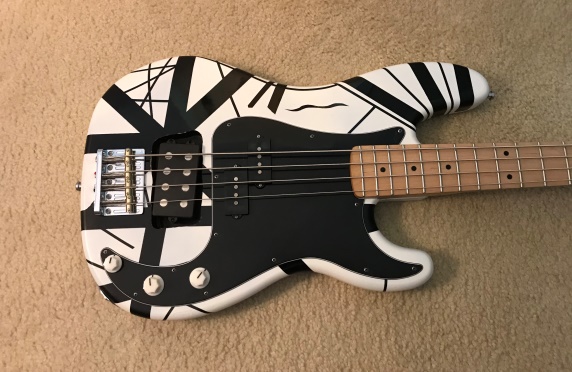
FENDER EVH 78 FRANKENSTEIN BASS
Under construction...
Van Halen's 1978 black & white Frankenstein guitar
my EVH 78 Frank guitar
black Fender Squier Affinity PJ bass body
taped stripes and painted white
brass saddles and slanted MM humbucker pickup
brass nut
side jack and vintage white Jazz knobs
a pair of 78 Frankensteins
looks great and plays even better
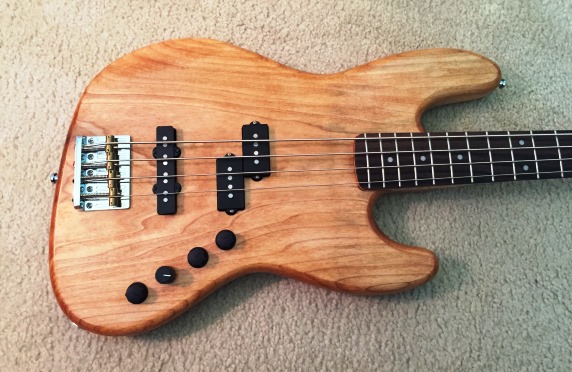
FENDER PJ JAZZ VINTAGE BASS
Finally a fretted bass guitar with a P+J set up. And with a one-piece body.
During the summer of 2016, I found a shop on eBay selling one-piece bass bodies with some cool options for less than $100. So I ordered a Jazz body made out of a solid block of poplar. One piece of wood. Very cool. I had them route the Jazz body for a Precision+Jazz pickup configuration (P+J) and a standard Fender bass bridge. For the neck, I went with a consistent Mighty Mite Jazz bass neck with a rosewood fretboard.
Now I already had a bass with a P+J set up in my Fender Squier P Bass Special Fretless, but it's tough to play accurately. So I was really looking forward to getting a fretted bass with the versatile P+J combo. And to make it even more versatile, I got the body with four control holes drilled and purchased a prewired harness that includes a volume for each pickup, a master tone, and a 6-way rotary tone that really tweaks the tone frequencies. Very cool set up. For the pickups, I went with a relatively new company, CALIG (California Guitar), and went with their California PB and California Split JB (bridge position humbucker). Great pickups and they fit the routes perfectly.
Because the body came unfinished I had a clean slate to play with. Because it was a nice one-piece body, I decided to go with natural golden pecan stain (by Varathane) - the same stain I used that summer when refinishing some furniture. The front turned out super clean and back of the body had a dark streak/patch, and the stain really brought that out to an almost greenish color. The front looks great with the hardware installed and the nice matte finish.
For the final chrome accessories, I added Schaller straplocks, Fender Squier tuners, a Fender vintage bridge with brass saddles, a Fender neck plate, and a Fender Fatfinger clamp that attaches to the headstock. It really makes a difference in tone and sustain.
Overall, a pretty quick project and the final product came out well done. A very versatile bass that has vintage cool looks and a wide variety of tones. Finally!
February 2017
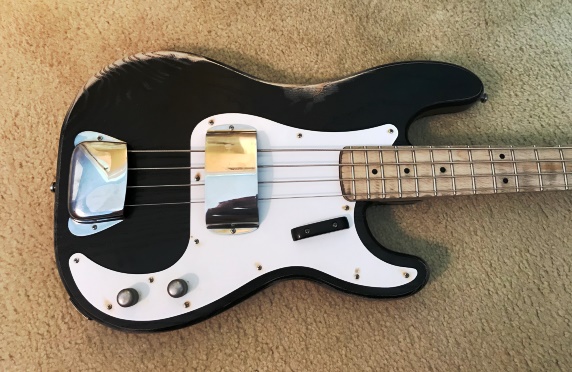
FENDER PRECISION BASS -Active Vintage-
This has to be the most classic bass I have. With some modern appointments.
After seeing some pics of a '57 Fender Precision Bass re-issue, and the associated heavy relic '57 Fender Precision Bass re-issue 1 2 3 4, I really wanted to try and put something like that together. The key was to understand the history of the Fender Precision Bass and I ended up focusing on a two-year period of classic Fender PBass updates:
1956 - last year for: 2-saddle bridge, strings-thru-body (ferrules), side jack (Fender switched from ash to alder in 1956 for main body wood)
1957 - first year for: "Strat" headstock, split PBass pickup, 1-piece pickguard, 2-screw plastic thumb rest (instead of 1-screw wood rest), flat-top knobs
I really wanted to combine some of my favorite features from these two years, so my tribute bass would be something like a late '56 or early '57 model. From 1956, I took the 2-saddle bridge with the strings-thru-body (ferrules) and side jack, and tracked down an ash body. And from the 1957 spec changes, I borrowed the "Strat" headstock, split PBass pickup, 1-piece pickguard, and 2-screw plastic thumb rest ideas.
For the ash body, I went with Rosser Guitars and it's a beautiful, center-joined '57 body routed for a side jack. And for the neck, I simply used a Mighty Mite maple PBass. The wood fit together perfectly, and I was ready to spray the body black. Easy work and the ash grain on the Rosser body looks killer. Lastly, I aged the body a bit to give it a nice, road worn look.
For the PBass pickups, I wanted to do something more modern and go with a set I've never used, so I decided on active EMG PA Bass pickups. This harness requires a 9-volt battery, and there really isn't a lot of room in the PBass cavity under the pickguard, so I routed a small compartment on the back and installed a plastic battery holder. The EMG harness comes with everything - volume and tone pots, stereo jack, and all the wiring/connections, so that wasn't too hard to assemble.
For hardware, I ordered a custom white PBass pickguard from Warmoth (no third control hole for the output jack), a vintage Fender thru-body bridge with two brass saddles, chrome tuners and a neck plate from Fender, Schaller strap buttons, and aged dome knobs from StewMac. I also found the appropriate chrome bridge and pickup covers, and the bass looks vintage great with the covers and without the covers.
The bass looks awesome and the EMG pickups are incredible. And thanks to Rosser Guitars for making such a great body - a perfect project from start to finish!
September 2018
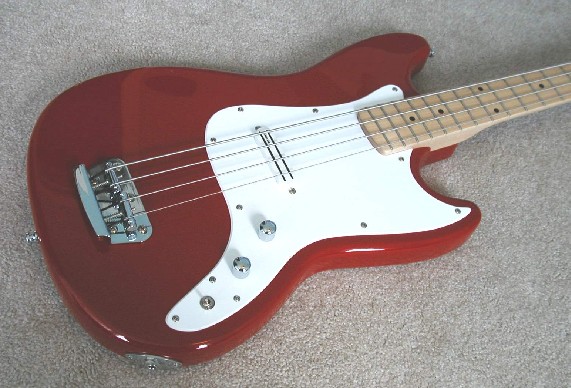
FENDER SQUIER BRONCO BASS
This is one cool bass. Since I already had a 34" and 32" bass, I thought I'd go with a 30"-scale bass. Plus, it looks really cool and has a totally unique sound.
I came close to buying a Bronco bass for a long time, but finally decided to go for it in late 2003. I found a place on the Internet (Music 123) that sold them ridiculously cheap, and figured I wouldn't have to do too many mods to get it where I wanted it.
The body is made of agathis and the neck is maple - both keepers. I thought the stock bridge was pretty sturdy, so I stuck with that. The pickguard and the control pots were OK, too. But I did make some changes. First of all, to continue my tradition of no headstock logos on basses, I sanded of the Fender Squier logo. I also sanded down the back of the neck, taking off a lot of the satin finish. I replaced the stock tuners (garbage) with chrome Gotohs and used Tung Oil on the back of the neck.
For the body, I added chrome Schaller straplocks and mini chrome Carvin knobs. I also drilled a jack hole for the side, and used the extra face hole on the pickguard for a coil-split switch. Lastly, I junked the stock single-coil pickup (couldn't even sell it on eBay!) and replaced it with a white DiMarzio Pro Track rail humbucker. I know, I know - that's a guitar pickup, but it sounds really cool! It's definitely different than my other basses, which is the kinda the point, right?
February 2004
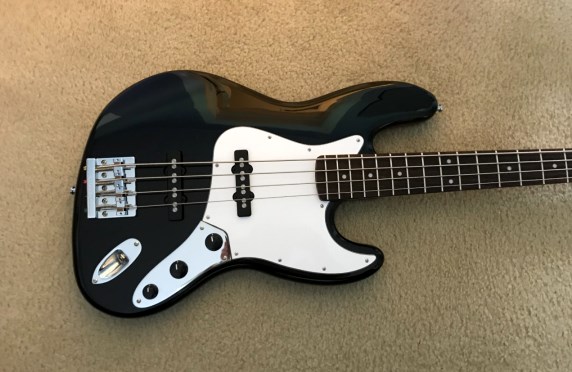
FENDER SQUIER JAZZ BASS
Under construction...
Interpol's Carlos D with his black Fender Jazz bass, circa 2002
Kluson High Mass bridge and custom route for Strat jack plate
Seymour Duncan Quarter Pound Jazz pickups
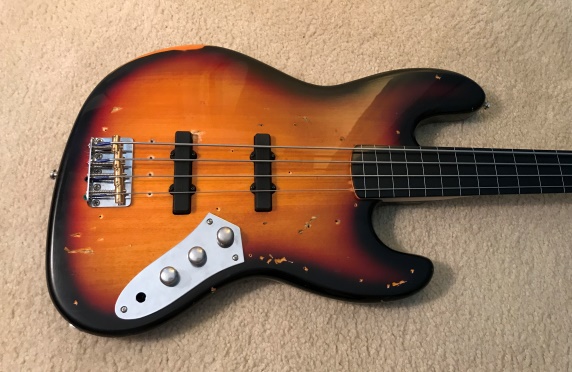
FENDER SQUIER JAZZ BASS FRETLESS
There's nothing like buying a perfectly good musical instrument and then drilling holes in it.
I first heard/read about of bass extraordinaire Jaco Pastorius in the early 1980s when I began playing, but I really don't think I heard any of his music until years after that. In early 2018, I watched a documentary about him and set out to build a replica Bass of Doom. Fender has made it's own relic'd copy of his iconic bass - a 1962 tobacco sunburst Jazz bass with the frets removed. But I didn't feel like coming up with thousands of dollars, so I decided to go a different, cheaper, and more fun route.
More info on the Bass of Doom.
Squier has made a Vintage Modified Jazz Bass Fretless for a number of years and it looks very close to Jaco's Bass of Doom (not fret dots and the burst is a little different, though). I found a smoking deal on a 2008 used model, and I went to work disassembling it. I actually was able to keep quite a bit of the stock parts - the body and neck, the tuners, the string tree, and the control plate. I also re-used the Squier bridge, but I did swap out the stock saddles for brass ones (Wilkinson). Other new parts were Schaller strap buttons, aged chrome knobs from StewMac, and a Fender F neck plate.
And then it was drilling time. The Squier bass doesn't come with a pickguard, but the Bass of Doom had one installed at one time, so I began to drill all sorts screw holes in the body to match Jaco's bass. He had holes for string dampeners, pickup and bridge covers, a thumb rest - you name it. It was a lot of holes! I then sanded the fretless neck headstock to remove the Squier logo. And then it was a lot of relic'ing to somewhat approximate the years of damage on the Bass of Doom - body closeup and body back.
I didn't keep the stock Duncan Designed Jazz pickups (sold them on eBay), so I upgraded to a Bartolini 9J1 set. I wired them up with CTS pots (2 volume, 1 master tone), a Switchcraft jack, and a .068 Orange Drop capacitor. The fourth hole on the chrome control cover is empty, as I drilled a 7/8" side hole for the Electrosocket/jack. I hate the body face jacks!
Like all fretless instruments, it takes a while to get a feel for it, but those Bartolini pickups put out a nice, clear tone. The lined fretless neck is like glass, and it looks like an old vintage instrument. Overall, a fun project!
May 2018
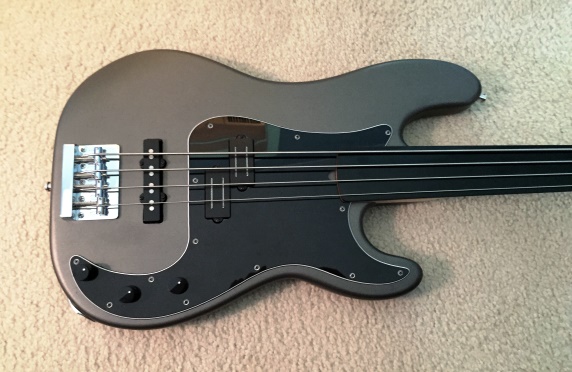
FENDER SQUIER P BASS SPECIAL FRETLESS
After putting together a fretless guitar, I thought it may make sense to assemble a fretless bass.
For the money, I think Fender Squier basses are amazing, and even though there is a Squier fretless Jazz Bass, I wanted this fretless to have a Precision+Jazz (P+J) pickup configuration. And luckily, there was a Fender Squier bass (P Bass Special) with the P+J in a cool pewter color. My next decision was to buy that bass and pull the frets out myself, or replace the neck with a Mighty Mite fretless neck ($100). Thankfully, the decision was kinda made for me when I tracked down a loaded pewter body (agathis wood) on eBay. That way, I just had to get the neck and saved myself the headache of having to pull frets - whew!
The Mighty Mite neck is incredible. It does not have any face lines or dots (only side dots), and it's maple with a man-made Ebonol fretboard. This stuff is super-tough! I thought I would try and roll the fretboard edges a bit, and it was like trying to do work on a granite countertop. Anyway, another quality Mighty Mite product. And it fits the Fender Squier pocket perfectly. And it came with a nice grooved nut and accepted the Fender Squier bass tuners I picked up perfectly. I should also explain a little rule I have with basses - if it's a Fender-type headstock design, I sand off the logo. That's why I didn't go with any decal for this headstock.
But of course, the Mighty Mite neck and Fender Squier tuners weren't the only modifications to this bass. While I love the pewter color, I thought it would look better with a white pearloid pickguard than the stock black one, so I picked up a cheap one from Guitar Fetish and I was in business. I then picked up a serious All Parts bass bridge - a nice heavy chrome one for top-loaded strings. Years ago, I had purchased some black beveled knobs from Stewart-MacDonald and I thought these would look nice with this project. And I replaced the stock strap buttons with chrome Schaller straplocks. (I also junked the stock Squier neckplate and replaced it with a chrome Fender one.)
And then there were the P+J pickups. I had no doubts that the stock Squier pickups were decent, but I really wanted to "hot rod" this bass, so I went with a set of DiMarzios that would rock - a Split P in the middle and an Ultra Jazz Bridge for the bridge. The Split P is a lot more powerful than a typical vintage P Bass pickup, and the Ultra Jazz - unlike standard Jazz Bass pickups - features two coils (humbucker). And it's loud, too. I got lucky and found a used Split P on eBay and saved some $$ that way.
Overall, I was able to put this thing together for around $375 and it's super solid and puts out a loud tone. And the Ebonol fretboard is like glass - I'm glad I went with this neck. Now I just have to practice playing it.
March 2010
UPDATE: May 2018
I decided to rip the stock guts out and replace everything with quality parts: 2-500K XGP pots (volume), 1-330K XGP pot (tone), a Switchcraft jack, and an Orange Drop .068 capacitor. Before wiring everything together, I decided to ditch the white pickguard and go back to the original look with the black guard.

FENDER SQUIER PRECISION BASS
My first bass! I decided to break down and buy a bass back in 1987, when I worked at Guitar Center in San Diego. Mike Petersen and I co-owned a Fostex 4-track recorder and we were recording original material left and right - he had a Rickenbacker bass that I used to borrow. I decided to get my own bass.
I bought a white, 32"-scale Fender Squier Precision bass, made in Japan. I really liked the fact that it was medium scale - it made it easier for me to play. Of course, I wasn't thrilled with all the hardware, but I loved the basswood body and neck (rosewood fretboard). I spent a lot of time sanding off all of the finish off of the back of the neck - the neck now feels great. I swapped out the stock bridge for a chrome Leo Quan BadAss II bridge. I replaced the stock pickups with Seymour Duncan P-Bass Quarter Pounders. I switched the strap buttons to Schaller straplocks. The stock tuners were pretty good, so I left those alone. This was my bass for about eight years.
In 1995, I got really sick of the white paint on the body, so I stripped all of it off (hard work!) and left it natural. I also routed out some wood for another pickup - a Seymour Duncan Single-Coil Quarter Pounder for the bridge position. Adding the extra pickup and a three-way switch gave me another bass tone for recording.
In 1997, I changed my mind about the natural look of the bass, and I painted it light blue, trying to get close to the old Fender light blue used on Strats. I think I got pretty close - it especially looks good with the stock white pickguard. That's the last modification, and I think I'm going to leave this bass alone now. It sounds great, and the necks has an incredible feel to it.
February 2002
UPDATE: March 2013
Bad news - the electronics in my favorite bass kinda died. I grabbed it to record something and the bridge single-coil pickup doesn't work at all and the volume pot drops from 10 to 0 with just a touch - no tapering. So I went ahead and replaced the Seymour Duncan Quarter Pound Single Coil pickup (a new one is around $50), and all the pots with Carvin 500K solid-shaft mini pots (the control cavity is very tight). I also lost the Gibson-style 3-way switch in favor of a master tone, and added a new Sprague Orange Drop .047uf cap. So now the bass will have a volume for the neck pickup (Quarter Pound P-Bass), a bridge pickup volume (Quarter Pound Single Coil), and a master tone. So three knobs instead of two and a switch. Also, I replaced the jack with a Switchcraft and wired everything back up to the new format. I had to add some plastic to the pickguard in order to make the pickguard control holes smaller, but that wasn't too difficult. I also replaced the original plastic nut with a Tusq bass nut. Still the best bass on the block.
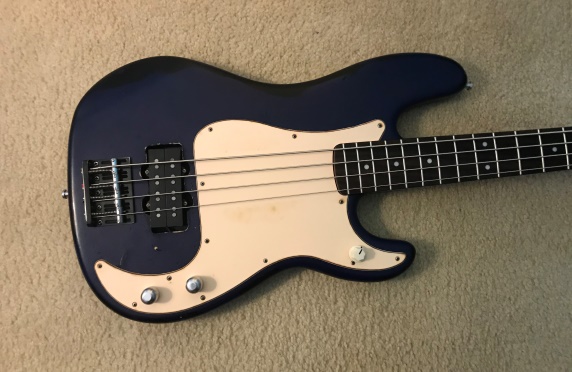
FENDER SQUIER PRECISION HB ROAD WORN BASS
U nder construction...
black vintage sustain bridge with chrome saddles and Artec Jazz Dual humbucker pickup
Artec humbucker hidden under the pickguard with dedicated volume control
aged body front and back with custom Strat output jack
beautiful figuring on the back of the Danish Oil-stained neck
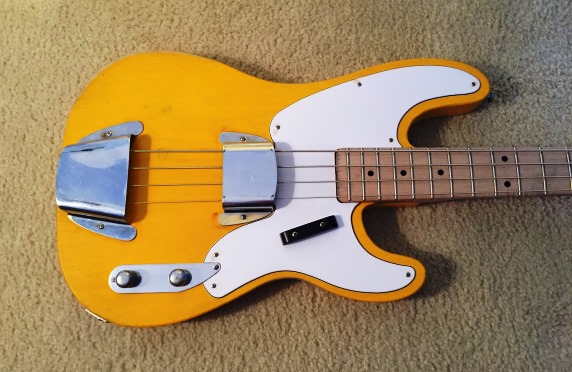
FENDER VINTAGE PINE TELE BASS
With all the Pine Tele action, I had to go for a bass, too!
There's just something about Pine and there's just something about Telecasters, so why not build a pine Tele Bass? After working up a whole mess of pine Fender Telecasters, I tracked down a builder on eBay who made pine slab (no contours) Tele Bass bodies at a great price. My goal was to get my bass project to look something like the older Fender Tele Bass, with that vintage-looking body, although I couldn't decide if I wanted to go for the pickup and bridge covers, or to just leave it uncovered. I thought the covered look was better and I can always take the covers off.
So with the body in hand, I purchased an unfinished maple All Parts Tele Bass neck, which wasn't too cheap. But it's well made, looks good, and it fits the body perfectly. Now I had all the wood ready. I aged the neck and painted the body a golden yellow color to get close to the old Fender butterscotch patina. So far, so good. I then aged the body and I was ready for hardware.
For the bridge, I purchased a two-saddle, vintage-looking Fender bridge that anchors the strings through the body. I didn't have too much of a choice, since that was the bridge that this body was routed/designed for. I found a set of used Fender Squier tuners, and after opening the tuner holes a bit and aging them, they fit perfectly. I added some aged Schaller strap buttons, a white pickguard, ebony thumb rest, a Fender neck plate, and a chrome Fender control cover. To get the pickguard aligned with the control cover, I had to enlarge the control cavity just a bit, which forced me to add some wood so the control cover screw had something to grab into. It's always something. I wanted to use an Electrosocket for the side jack, but there was a hairline crack there in the pine, and when I went in with a 7/8" bit to clean up the jack hole, it began to splinter. I tightened it up with some wood glue and a screw (side jack issue) and it's stable now. But I had to go with a standard Les Paul-type jack plate. Oh well.
For the electronics, I wired up a volume and tone with a Seymour Duncan Hot Single Coil P-Bass, and it gets me that beefed-up, vintage tone. I think the bass looks great with the aged bridge and pickup covers, but it still looks cool with no covers. I've wanted this for a while, and now I finally have that pine Tele Bass!
November 2017
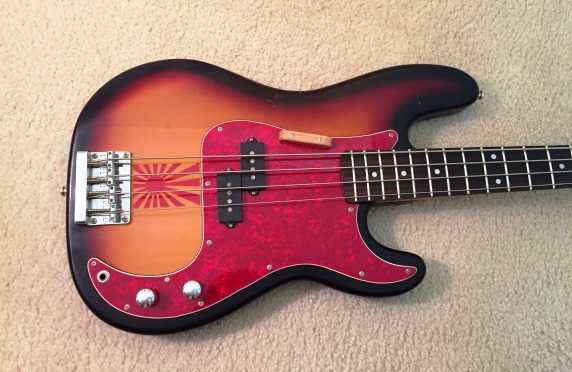
TOKAI CLASSIC P BASS
My second bass from Rondo Music. And another quality instrument at a ridiculously low price. (And that saves my money for mods!)
While cruising Rondo Music's site one day, I saw a nice sunburst SX P Bass with a unique headstock for $110. Yes, $110. Unbelievable. The neck is maple and the body is alder. The only question left was how many to buy?
Well, you know there are going to be some modifications to a $110 bass, right? First, I swapped the stock strap buttons with chrome Schaller straplocks. I replaced the chrome SX neck plate with a chrome blank one, and I junked the stock white pickguard for a red pearloid one I picked up on eBay for $20. So what did I keep? I thought the stock chrome tuners and stock chrome knobs were sturdy, and the pots, output jack, and wiring were surprisingly clean. That left the bridge and the pickup. $50 should take care of those.
For the P Bass pickup, I went with one of Guitar Fetish's new GFS PB Pro Plus ($35) and it's definitely louder than a stock vintage-sounding P Bass pickup. Then I found an amazingly heavy top-loading chrome bridge on eBay for $15. I also added an oak thumb rest and it's kinda cool how easy you get used to using these things.
For the headstock, I didn't want to stick with the SX logo under the vintage/orange clearcoat, so I sanded down the headstock face and back and applied a black vinyl Killer decal (see below for update). I've never owned anything from Killer guitars - and they don't currently make anything like this - but I have to admit that this Japanese manufacturer does makes some cool axes (especially the EVH Shark-looking model).
That's it. A super-simple project that came out really, really nice in terms of both vintage looks and modern tone.
March 2010
UPDATE: August 2016
I thought this bass needed a change, as I didn't like the way it looked - too boring. So I ordered a new SX bass neck with a different headstock (blank) and a rosewood fretboard. I also found a guy on eBay that made vinyl Tokai decals, so no more Killer (maybe one day I'll get a real Killer guitar). I was able to re-use the existing tuners, so no hardware changes - just a new neck with a Tokai logo. I aged the body a bit more, and added a rising sun decal next to the bridge, which seems to match and looks pretty cool. And that's about it - I think it looks better and the SX rosewood neck plays great!
UPDATE: April 2018
I decided to rip the stock guts out and replace everything with quality parts: 2-250K ALPHA pots (volume/tone), a Switchcraft jack, and an Orange Drop .1 capacitor. I wired everything up and although it looks the same, it now has top-of-the-line components under the hood!
Other BASS-IC related stories:
BadAss Bridges
My Fender Basses and the Headstock Logo
Squier Thin Body projects
previous story back to the BEHIND THE GUITARS page next story
















